The Air Force is revamping its expeditionary air system to cope with a stark reality: The service has too few airmen and too little equipment to meet desired rotational goals.
Fewer than half of all airmen deploy at the idealized rotation rate of four months out of every 20. The majority are in a now-institutionalized rhythm of longer deployments with less rest and reset time in between.
The new system is called “tempo banding.” In it, airmen are slotted into deployment cycles that vary by specialty. About 40 percent of airmen will still follow a “dwell” ratio of one-to-four, meaning one month deployed for every four months of home-based rest, training, and workup to the next deployment.
The majority of airmen, though, have been recast into tempo bands with dwell ratios of one-to-three, one-to-two, or one-to-one. These groups face deployment periods of 179 days or longer.
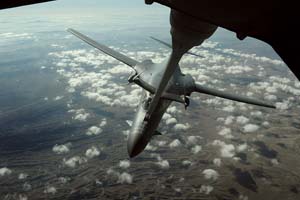 |
|
The new scheme offers no relief to the most in-demand but shorthanded specialties, such as combat search and rescue personnel. They are still stuck in a six-months-away, six-months-home cycle. However, it is intended to give all airmen a greater degree of predictability and certainty about when they will deploy.
Dramatic Evolution
Moreover, because USAF is deploying so many specialties by individual, rather than by unit, home-based commanders will have more notice of when they will be losing a particular person or capability, and have more time to plan ways to mitigate those absences.
All in all, the construct of 10 roughly comparable air expeditionary forces—or “buckets of capability”—hasn’t been discarded, but has evolved dramatically since it was first formulated in the mid-1990s.
“I don’t see a reduction in the number of AEFs,” Air Force Vice Chief of Staff Gen. Carrol H. Chandler said in July. “At least, we haven’t talked about that.”
He acknowledged that the Air Force has come down substantially in force structure over the past few years, and is still in the process of eliminating 3.5 wings of fighters this year alone. However, he added, “We haven’t spent a lot of time thinking about … AEF reductions.”
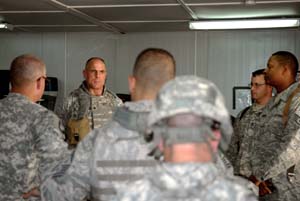 |
|
Eventually, the Air Force may have to decide between running its aircraft at a higher operating tempo to keep all 10 AEFs or consolidating to fewer AEFs, which “is an option, too,” Chandler said.
For the moment, AEF planners have “been able to meet the need,” and “as long as they continue to meet the need,” there’s no urgency to overhauling the construct, Chandler asserted.
Following significant cuts in airmen and force structure a few years ago, the Air Force recognized that many of its deploying units were only partially manned. It undertook a servicewide “scrub” to put partial units together to make good whole ones, and then assessed the new situation.
“When we looked at it, we decided that we needed to … take the next step from the 10 AEF bucket concept … to tempo banding,” said Col. James C. Horton, director of air and space expeditionary force and personnel operations at the Air Force Personnel Center, Randolph AFB, Tex.
“What that’s done for us is allow us to go in and more surgically … keep track” of how stressed each Air Force specialty is, “and be more effectively able to manage [them] … instead of just lumping them into a ‘rinse, lather, repeat’ cycle of 120 [days], where we were kind of wearing them out.”
Getting a Break
The new method almost eliminates the need to “reach forward” into future AEF cycles to pull airmen meant to be in their regeneration cycle to answer an immediate deployment need, Horton said. That practice, driven by necessity, led to a chaotic system where future AEFs were full of vacancies that had to be filled by reaching even further ahead into future AEFs, or extending the tour lengths of some people already deployed. It was unsustainable.
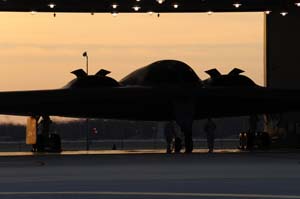 |
|
The reason why most specialties have shifted from 120-day rotations to 179 days is not just because of fewer hands, though, Horton explained. Those 120 days constitute the deployment window; they don’t “count” two months of time spent in intensive preparatory training. Such training would often require an individual to go away from home base, such as to a Red Flag exercise or an Army course in close-quarters combat. By expanding the dwell to 179 days in some cases, workup training could be accomplished just once in 20 months instead of twice or more. A similar rationale was behind moving from 90-day AEF deployments to 120 days, earlier this decade.
The goal is to put more “white space on the calendar,” and maximize both the deployed and home-station times, Horton explained.
By deploying at almost the individual level, some specialties have gotten a break. Security forces, for example, are in “Band E,” a one-to-one dwell of 179 days. However, that metric applies to whole units, which are “vulnerable” for deployment at the highest dwell rate. When individuals from those units are tapped, however, “they’re somewhere [in the] one-to-three [band], just shy of one-to-four in terms of dwell,” Horton noted.
“Our typical tasking [from a unit] is anywhere from two to five bodies at a time,” Horton said. “That’s how, surgically, we’re managing what’s going on out there.”
That shift has been possible because combatant commander requirements have also evolved, Horton noted. Combat aircraft units, for example, are in far less demand in Iraq and Afghanistan than they once were.
“The mission has changed,” Horton said, with greater emphasis on “hearts and minds” activities such as reconstruction and civil engineering, as well as “Army support,” than on dropping ordnance from aircraft. And because whole fighter squadrons, for example, are not required as much, “we’re … taking it down to the lowest level we need to: … onesies and twosies.”
He added that, “realistically, you don’t need the whole civil engineering squadron out of Elmendorf Air Force Base. What you need is, at any given time, 10 guys able to go in and do electrical work.”
The individual-specific tasking also gained importance because, Horton said, the Air Force doesn’t have the “luxury” of deploying as the Army does.
The Army can “take a whole brigade and shut the building and the power down, and the whole unit walks out the door and goes downrange. We still have our training mission … back at home,” so the home-base, garrison, mission must be recognized, accommodated, and balanced with the deployment need.
Horton maintained that “we haven’t broken anything at home yet,” although “I’d be lying if I told you there weren’t some areas that are stressed, at home bases,” and commanders are having to make tough choices about “what to not do at the level they normally would do if they had everybody home.”
He continued that there is a “larger combat mission that we still need to be trained for that is not just the … war we’re fighting right now. So, we’re trying to keep a balance on that, and it’s working quite well.”
Three Big Rotations
Numerically, more than a third of the Air Force goes on deployment at least once in a year.
“We’re doing three big rotations a year that number [about] 35,000 folks per cycle,” or 115,000 a year, Horton noted, out of an active duty force of about 331,700. Air National Guard and Air Force Reserve follow their own system, but are still coordinated through Horton’s organization. A majority of Guard and Reserve individual deployment requirements are met with volunteers.
Because they are not deployed as much, flying units seem to be in better shape than they were just a few years ago, Horton observed.
“We’ve brought some of them home or reduced the size of their footprint downrange.”
However, in specialties such as intelligence, expeditionary combat support, civil engineers, and security forces, “those folks are all very heavily engaged downrange.”
 |
|
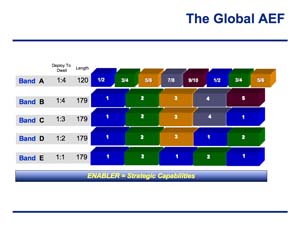 |
|
While some capabilities have been withdrawn because they are less in demand—bomb droppers, for instance—other aircraft have required a surge in deployments. The new MC-12 intelligence-surveillance-reconnaissance aircraft, for example, required what Horton called a “huge push” to become operational in-theater.
The ability to manage the AEFs at the individual level was enabled substantially by the 2008 split of the old AEF Center at JB Langley, Va. The hardware aspects of the AEF are still managed from Langley, but the personnel end moved to Randolph so that the AEF coordinators could be “face to face” with those managing the regular churn of duty assignments, the Directorate of Personnel Assignments. Together, they have made great strides in making it possible for individuals with heavy AEF commitments to get their professional military education, upgrade training, and other necessary career development, Horton asserted.
One of the problems that drove creation of the AEF, under Gen. Michael E. Ryan, then Chief of Staff, was that some USAF personnel were deploying constantly while others rarely did. The AEF was considered—in part—a tool to add some fairness to the system and spread the burden of deployments as widely as possible. It took until the tenure of Gen. T. Michael Moseley to get everybody in the Air Force into a “library” of people in the AEF system.
“There was a big push four or five years ago … to make sure everybody was deployable,” Horton noted, and “the Air Force is 100 percent deployable at this stage.”
 |
|
However, about 13 percent of airmen are considered “deployed in place” because of the unique requirements of their jobs. An obvious example is a missile launch officer in a ballistic missile silo; others include Predator and Reaper remotely piloted aircraft operators, who control their in-theater aircraft from control stations back in the US.
Even then, “those folks … are not totally off-limits” if there is a compelling reason their unique talents or abilities are demanded for an AEF, but such cases are rare, Horton said.
As Global Strike Command has stood up in the last year, it has roped off some of its people as nondeployers in order to get on its feet with a minimum of turbulence, as well as to quickly achieve the demanded high standards for the command’s activities.
Global Strike Command designated some personnel as deployed in place because it “wants … the continuity of those specially trained security forces there for that mission, and [so] they don’t go below a reasonable and prudent level,” Horton noted.
The AEF system does not award “credit” for having deployed or for having served in a deployed-in-place job, Horton noted.
“As soon as they come out of that position and rotate to another … job, then they’re back on the hook to deploy just like everybody else.”
Some jobs deploy at durations beyond the tempo bands. Expeditionary group and wing commanders serve a one-year tour, as do contracting officers and other specialties. These officers serve that long because of the need for continuity in the job, and the high importance placed on familiarity by partners in Afghanistan and Iraq. Obtaining trust requires building a long-term relationship that cannot be achieved in just a few months, or even half a year.
Stocking the JETs
The Air Force also has to provide about 6,000 people a year for joint expeditionary taskings, or JETs. These are jobs fulfilled by airmen that would normally be accomplished by Army or Marine Corps personnel, but in order to spare as many troops as possible for combat, airmen and sailors step in to perform these functions. The JETs used to be called ILOs, for “in lieu of” assignments.
To a large degree, JET positions are filled with volunteers. Horton said they volunteer for many reasons; some will be doing a job well above their normal responsibilities, or well outside their usual function, and these jobs can actually be competitively assigned. Some JETs are filled by volunteers who simply want to be “in the fight,” he said.
However, volunteers are supposed to step forward for JETs during the period when they would normally be vulnerable for an AEF deployment. That keeps the turbulence of missing personnel at home base to a minimum. If a volunteer wishes to serve in a JET job off-cycle, his commander must agree, due to the strain the absence would place on the home-based unit.
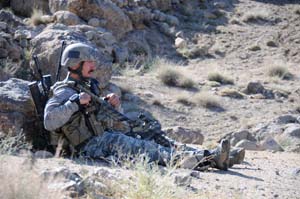 |
|
On average, airmen going to a 120-day deployment now get notification of where, specifically, they will be going about 80 days before “first movement,” Horton said.
“That is not the date they show up in the AOR; that’s the first time they have to go out the door” to do workup training. The airman will already know what AEF he’s in and what tempo band, so it will not be a surprise that the deployment is coming up. The notice refers specifically to his destination, so that he has time enough to get shots, training, and other affairs in order, to be ready when the time comes. It’s now only rarely that an airman gets the word “a week ahead of time,” he said.
For those going on a six-month deployment, notification time is now typically four months.
“How much are we reaching forward?” Horton asked. “Very little.”
“If you … promise … they don’t have to go for another four cycles, and then you reach forward, well, you’ve just broken your promise.” The tempo banding “has helped in not having to reach forward,” and will work to eliminate that problem and the frustrations that ensue for the airman and his family.
The AEFs are not exclusively about sending forces downrange, however. They are best thought of as a mechanism by which forces are presented to combatant commanders to meet their needs.
Custom Demands
For example, while there is limited demand for air superiority F-15s in Iraq and Afghanistan, there is a requirement for these aircraft from US Northern Command for Operation Noble Eagle air sovereignty missions, and in Pacific Command and European Command, noted George Nelson, an AEF program analyst for Air Combat Command. ACC continues to manage the deployment of hardware for the AEFs.
“That is a 24/7, 365-day mission that’s being done,” Nelson said. “Just because [a squadron is] not sitting … [in] Iraq or Afghanistan doesn’t mean it’s not participating.”
Likewise, bombers assigned to Global Strike Command are still available to be deployed in AEFs, according to Hal Burns, also an AEF analyst for ACC.
Although there must be coordination with US Strategic Command regarding the assignments of bombers, “we use them as a deployable asset,” Burns said. “They’re just like any other Air Force squadron. And if we need them, then we try to use them, and schedule them.”
The Air Force is employing some methods to spread its more limited hardware around the AEFs. For instance, if two squadrons from the same wing deploy to the same location in back-to-back AEFs, “one squadron will take [the aircraft] over [to the theater], and another will bring it back at the end of the two AEF periods,” said Burns. In such deployments, only the personnel will change out in between. This technique saves the expense of taking a dozen aircraft across the ocean two times, reducing wear and tear on the aircraft.
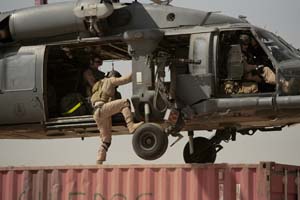 |
|
“If it’s a different unit, normally the airplanes stay with the unit and they bring them back, and the new unit will bring its own airplanes.”
He summed up the approach as “whatever works.”
When originally conceived, the AEF was meant to divide the Air Force into 10 buckets of capability that would be roughly equivalent, with comparable numbers of air-to-air fighters, bombers, strike aircraft, ISR, etc.
“We try to make each bucket equal” still, Burns noted. However, “what deploys … forward from each bucket is what the theater commander requires. So, in the case of the F-15C, if there’s no requirement to go overseas—if the combatant commander doesn’t have a requirement for them—then they don’t go, but … they’re still in the AEF bucket and they rotate through just like all the others.”
It’s important to distinguish, Nelson cautioned, between “presentation” of forces to the COCOM and the actual deployments.
“The actual sourcing … comes from the larger pool, and we do whatever’s necessary” to meet COCOM requirements.
He added that the AEF structure of 10 buckets of capability “has value beyond just [trying] to make them all look equal and then match them to a requirement. That’s never occurred before. They were never equal from Day 1. … They never perfectly matched whatever the combatant commander’s requirements were. We’ve always had to adjust, depending on that.”
Looking ahead, and taking into account the reductions in force structure now taking effect, Nelson said the tempo banding is the logical response to “where we are.”

